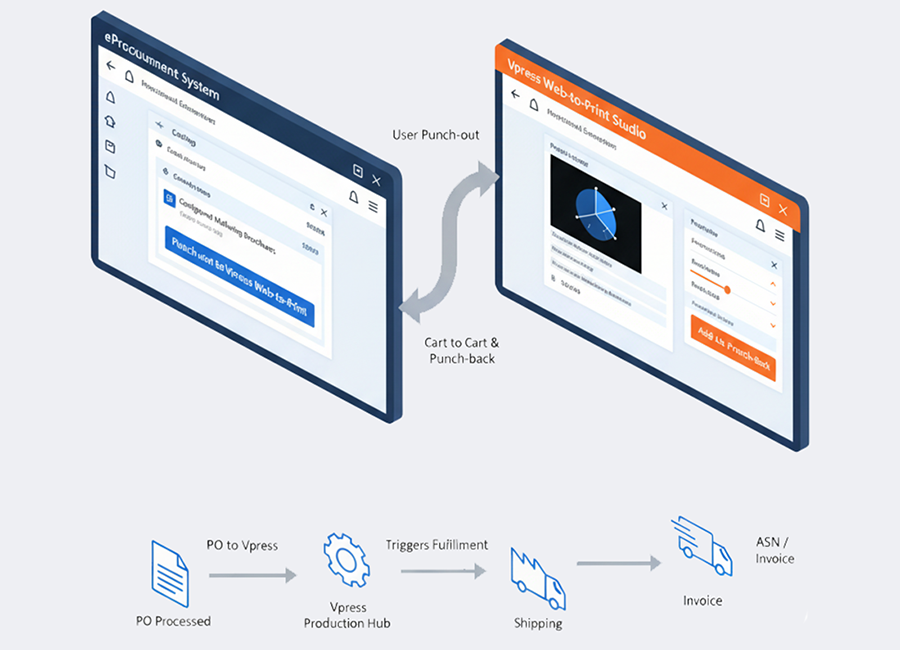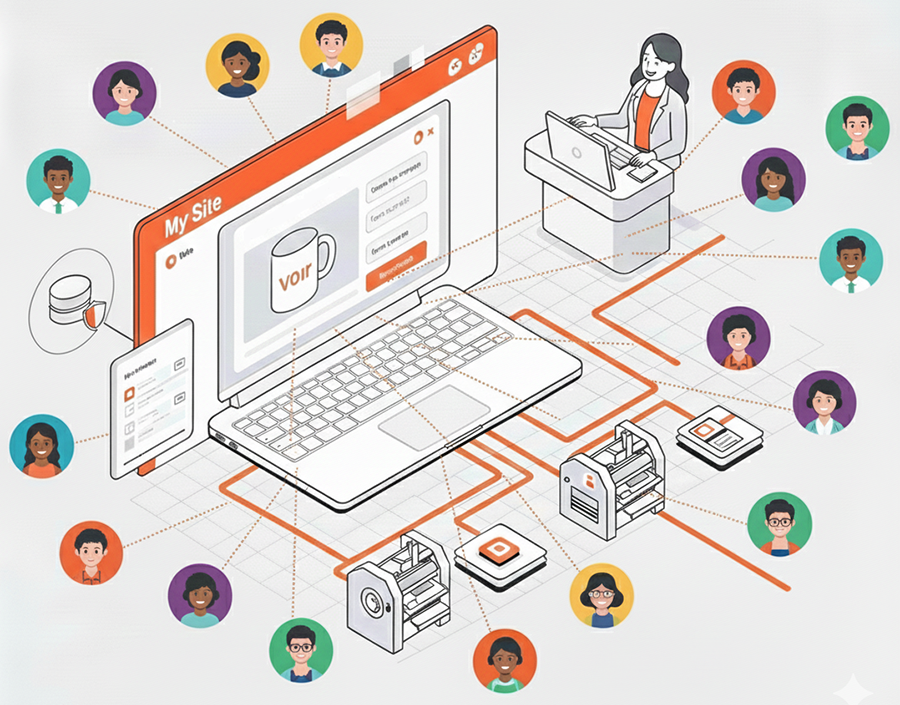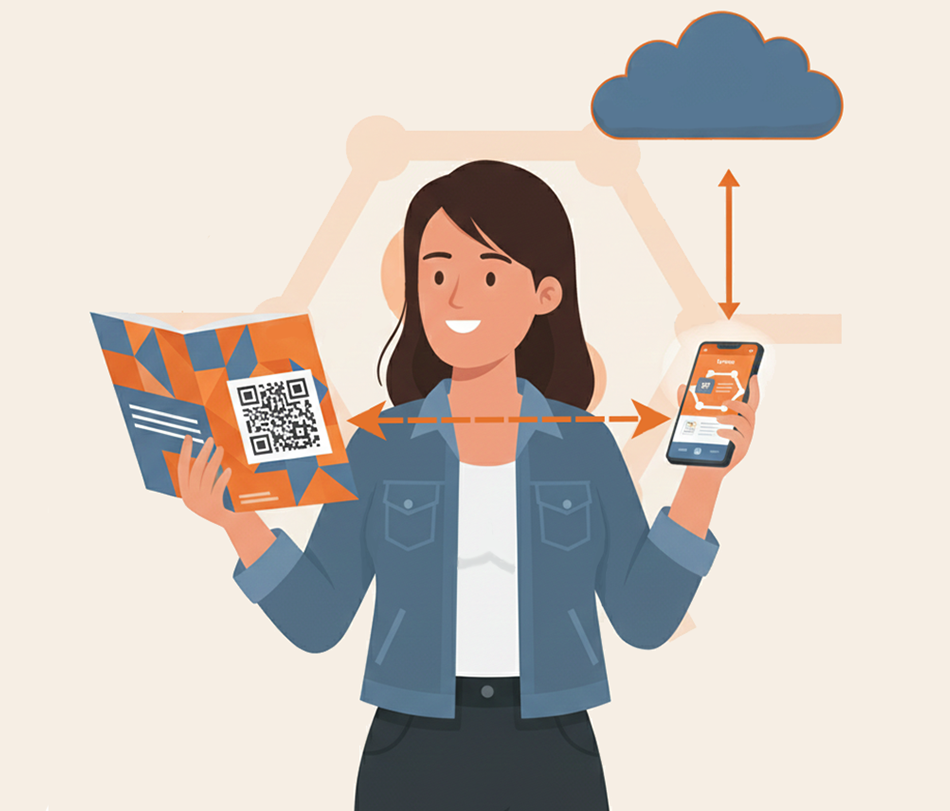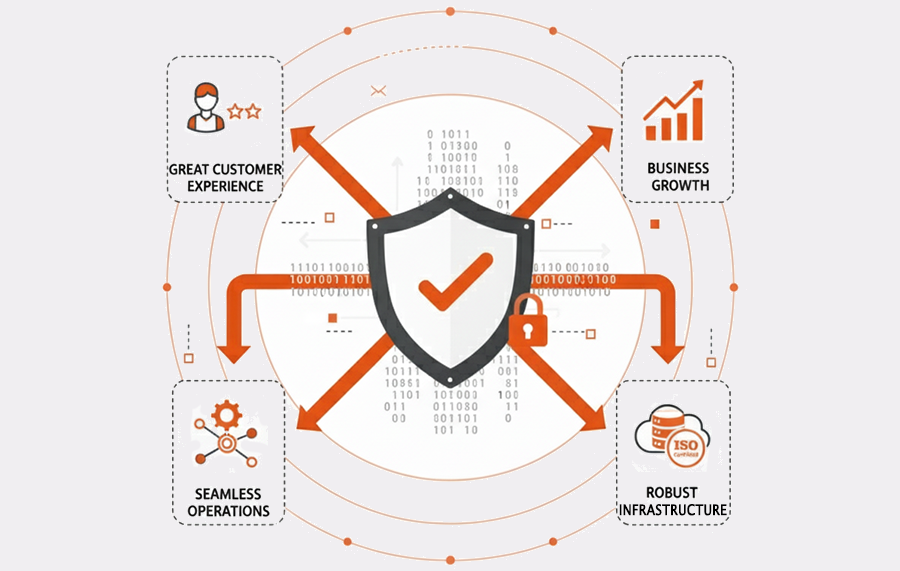22 October 2025
Web to Print Integration: The Crucial Bridge Solving the Complex Procurement Gap in ProcureTech

The global Procure-to-Pay (P2P) landscape is dominated by powerful, feature-rich software suites like SAP Ariba, Coupa, and Jaggaer. These platforms are brilliant at standardising transactions, enforcing contracts, and achieving spend visibility for simple, commodity items. They are the cornerstones of digital procurement.
However, they share a critical, often-overlooked limitation: they fundamentally struggle with the procurement of complex, customised, or variable print products.
This is where a modern Web to Print solution steps in, acting as the crucial piece of middleware that extends the capability of your multi-million-pound eProcurement system to handle everything from personalised business cards and bespoke stationery to complex marketing signage and branded merchandise.
The Achilles' Heel of eProcurement: The Customisation Conundrum
Traditional eProcurement platforms are built on the principle of the Static SKU (Stock Keeping Unit). This works perfectly for simple, indirect spend goods:
SKU 45291 = Black Pen, Box of 12 -> Price: £15.00
But when you try to procure a customised marketing brochure, the product definition explodes. Trying to manage every permutation of a complex product like this as a unique SKU directly within an ERP or eProcurement catalogue creates major enterprise headaches: data overload, supplier management complexity, and a frustrating, error-prone user experience. This is the gap that Web to Print software is specifically designed to fill.
The Supplier's Dilemma: Catalogues and Order Chaos
While enterprises struggle with the buying experience, suppliers face an equally daunting challenge: maintaining accurate product data and efficiently processing orders. Standard P2P catalogue management systems demand that every product variation (even a business card with 10 variables) be represented by a vast, complex data file. This leads to data maintenance hell for the supplier, resulting in stale pricing, incorrect specifications, and a constant need for costly, manual updates.
A best-in-class Web to Print solution solves this by providing a single, intuitive Supplier Console. This platform allows the supplier to manage complex dynamic product templates, not thousands of rigid SKUs. Once configured, products are instantly published to the PunchOut catalogue. Crucially, when an order is received back from the P2P system, the Web to Print system processes the data into a clean, print-ready file, triggering fulfilment either directly through the portal's integrated workflow or via configurable automation channels straight into the supplier’s internal order fulfilment processes. This transforms a manual, high-risk workflow into a seamless, automated operation.
Web to Print: The Engine for Complex Product Procurement
A modern, enterprise-grade Web to Print solution resolves this complexity by handling the product configuration outside the rigid data structures of the core eProcurement platform. This delivers a complete solution for print brand compliance.
Beyond Print: The Advantage of Complexity
While the technology is called "Web to Print," its capability is no longer limited to paper. Because print items involve numerous interdependent variables (paper weight, coating, imposition, finishing, cutting, etc.), the underlying Web to Print logic is arguably the most robust dynamic configuration engine available in ProcureTech.
This means that once a Web to Print system is in place, managing other complex, branded, or customised products becomes comparatively easy:
- Branded Merchandise: Configure an item by size, colour, logo placement, and embroidery/print method.
- Uniforms/Apparel: Select size, gender, department, and custom patch location.
- Signage: Input dimensions and material (e.g., acrylic vs. vinyl) for an instant, accurate price.
The Web to Print system becomes a single complex product configurator gateway, centralising the procurement of all bespoke corporate assets.
Enforcing Brand and Contract Compliance
The most powerful strategic role of Web to Print is its function as a brand governance tool.
When a Web to Print template controls the procurement process, it inherently prevents maverick spending and brand violation. Every item procured through the portal is guaranteed to use the approved vendor, the contracted pricing, and the official brand assets. The buyer is given creative freedom only within pre-defined, compliant guardrails, ensuring consistent brand application globally.
The Technical Crux: Web to Print via PunchOut Catalogue Integration
The magic that allows Web to Print to work within the confines of an existing eProcurement system is the PunchOut Catalogue integration protocol. This is how the specialised Web to Print tool talks to the centralised P2P platform (SAP Ariba, Coupa, etc.) while ensuring financial control and process compliance are maintained.
A Legacy of Integration Excellence:
Over 20 years ago, our Vpress technical team carried out one of the very first PunchOut roundtrip integrations for a major global organisation seeking to streamline its brand materials ordering. This pioneering work laid the foundation for the numerous successful integrations we have since delivered for some of the largest, most complex enterprises across the globe. We specialise in making the seamless connection between your world-class eProcurement software and the specialised needs of Web to Print.
The PunchOut Process Flow (cXML)
- Entry: The user logs into their SAP Ariba or Coupa application and finds a link to the approved print vendor's catalogue.
- PunchOut: The user clicks the link, which sends a secure, encrypted message (typically using cXML) that "punches out" the user from the eProcurement site to the supplier's Web to Print storefront.
- Configuration: The user configures their complex, customised item on the specialised Web to Print platform.
- Cart Return: When the user clicks "Checkout" on the Web to Print site, the system packages the complex configuration and dynamic pricing into a single, structured line item and "punches back" the cart data into the user's shopping basket within the original eProcurement system.
- P2P Governance: The eProcurement system takes back control. The item is now subject to the corporate approval hierarchy, budget controls, and Purchase Order (PO) creation processes.
Strategic Benefits for the ProcureTech Industry
By leveraging a robust Web to Print solution, organisations transform the procurement of variable goods from a high-touch, error-prone, non-compliant process into a highly automated, self-service channel.
Benefit | Impact on P2P Metrics (via Web to Print Solutions) |
Operational Efficiency | Reduced P2P Cycle Time: Eliminates manual steps (quoting, emailing, proofing) from the requisition-to-PO process. |
Spend Under Management | 100% Contract Compliance: Ensures every order uses pre-negotiated prices and approved vendors, dramatically reducing non-compliant spend. |
Brand Management | Global Consistency: Guarantees all branded assets adhere to corporate guidelines, protecting brand equity. |
A Crucial Distinction: Not All Web to Print Companies are Equal
The concept of a "Web to Print storefront" is common, but the ability to execute the enterprise-level, roundtrip PunchOut integration, which is absolutely vital for ProcureTech governance, is not. This is a technical hurdle that separates niche solutions from genuine enterprise enablers.
I believe we are on the cusp of more procurement organisations... realizing that the gains from better information far outweigh the costs of investment in specific technologies. Transformation is hard... but you have to just believe, 'okay, I have to keep talking about it'. They will come around, it's just natural.
Jason Busch, Founder of SpendMatters .
To realise the full efficiency and compliance gains referenced by industry experts like Mr. Busch, your Web to Print solution must be built for seamless, robust integration.
Vpress was not only a pioneer in this complex integration space two decades ago but has continually evolved its platform to be a future-proof bridge between the complexity of customised products and the control of enterprise eProcurement. When seeking to finally conquer your complex product spend, choosing a proven, specialised integration provider is the most critical decision. We believe Vpress offers the most reliable, battle-tested Web to Print solution for this purpose globally.
Ready to Streamline Complex Product Procurement?
Whether you're an enterprise looking to gain control over customised spend and ensure brand consistency, or a supplier aiming to simplify product management and automate order fulfilment, Vpress's Coreprint Web to Print platform offers the solution.
Discover how our pioneering technology bridges the gap between complex products and efficient eProcurement for both buyers and suppliers.
Request a Demo of Coreprint today and unlock smarter, more compliant procurement.
Frequently Asked Questions
What is Web to Print in the context of ProcureTech?
In ProcureTech, Web to Print is not just an online shop; it is specialised middleware that acts as a dynamic catalogue for complex, customised products (like print, uniforms, or signage). It integrates seamlessly with major eProcurement systems (like Coupa or SAP Ariba) to provide brand-compliant configuration and instant pricing, while the core P2P system retains control over approval and purchasing governance.
Why can't I just use my existing eProcurement system (e.g., Coupa or Ariba) to buy custom print?
eProcurement systems are designed for static products (fixed SKUs). Custom print involves too many variables (paper type, finish, size, quantity, personalisation) to be managed efficiently as static catalogue data. Web to Print handles the complexity of product configuration and dynamic pricing outside the P2P system, then passes one clean, final price and description back to the eProcurement system via PunchOut.
What is "PunchOut" and why is it essential for Web to Print integration?
PunchOut is a standardised B2B protocol (often using cXML) that enables a user to leave their familiar P2P platform, enter a supplier's specialised Web to Print catalogue to configure a complex item, and then securely return the shopping basket contents back to the P2P system for final approval and purchase order (PO) generation. It is the crucial technical link that enforces compliance.
Does Web to Print only handle print and marketing materials?
No. While it originated with print due to print's inherent complexity, modern Web to Print platforms are powerful dynamic product configurators. Because print requires managing complex variables, a quality system can easily handle the customisation, branding, and fulfilment of other variable corporate items, such as apparel, branded merchandise, and personalised signage. But is frequently used for the ordering of much simpler call off products in support of the supplier being able to more easily handle the fulfillment of the orders.
Web to Print Integration: The Crucial Bridge Solving the Complex Procurement Gap in ProcureTech
Table of contents
Share this article


